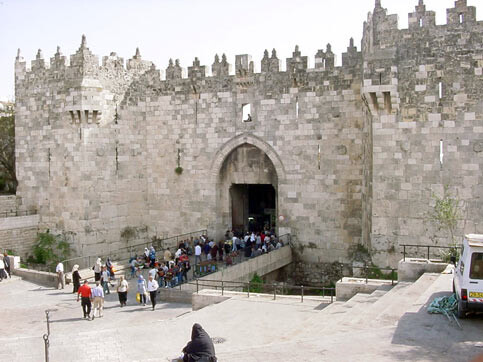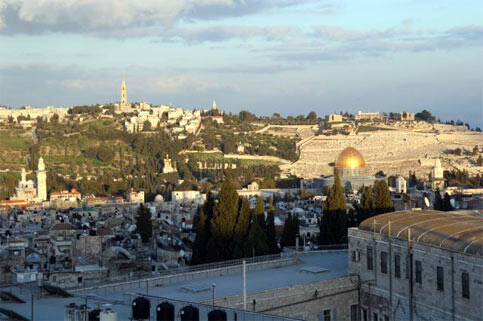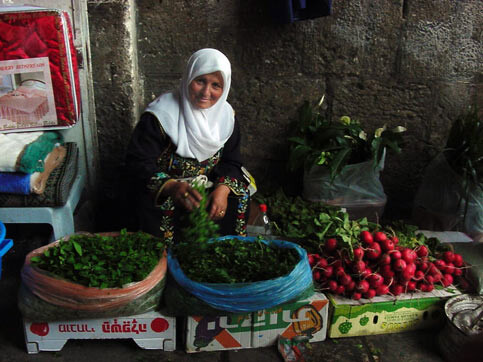4 April 2006
Friday, March 11, 2005 Jerusalem — Out of sheer exhaustion, I was finally able to get some meaningful sleep last night for the first time on this trip: Way too much stuff going through my brain and it is overheated; it has been impossible to just shut off at night.

An Israeli soldier keeps watch from a window in the wall above Damascus Gate. (Bill Dienst)
I awake early and look east down the hall window here at La Notre Dame. I catch the sun rising over the Mount of Olives and the Garden of Gethsemane. It is Friday, the Muslim Holy Day. The Mueza’ins are calling their faithful to prayer. The Jewish Sabbath will start at sunset tonight.
International Solidarity Movement
This morning, my friend Peter and I walk toward Damascus Gate in the heart of Palestinian East Jerusalem. We visit hostels where activists from the International Solidarity Movement (ISM) hang out. We meet mostly young idealists from around the world: England, the USA, Japan, Portugal, Spain, Germany, Sweden Bulgaria, etc. Many are guarded, until they figure out just who in the hell we are. Then slowly, they become more comfortable. Some who have been here a while have become a bit jagged around the edges.

The view from on top of Notre Dame looking at the Mt of Olives, the Garden of Gethsemane, and the Dome of the Rock. (Bob Haynes)
They are making final preparations before heading out to the village of Bil’in, west of Ramallah where the Israeli authorities continue building their hideous Wall. They are receiving final instructions on how to gel as a group, performing nonviolent action in conjunction with local Palestinians and also Israeli Peace activists.
They will probably experience sound grenades, and tear gas. Some may be beaten by Israeli soldiers and some may be arrested. Some may be deported. Some may be shot, with rubber coated metal bullets, or otherwise. In Gaza, Tom Hurndall was mortrally wounded by a Israeli sniper. Rachel Corrie was deliberately run over by a militarized D9 Caterpillar bulldozer, trying to prevent the destruction of a Palestinian pharmacist’s home. Brian Avery was shot in the face. All three had affiliations with ISM, and had stayed at this very same hostel, just like these inspiring young ISM activists in front of us now.
Today, these internationals will stand there with the local Palestinian villagers in solidarity, as the Caterpillar earthmovers and bulldozers rip out ancient olive trees from the earth. They also rip farmers from their main source of income, and Palestinians from their land. These activists are making sure that the whole world is watching. But does “The Whole World” even care?
It feels like Peter and I are honor guards sending the troops off to the front. But these troops are unarmed.
No one can say exactly who founded the International Solidarity Movement. It all coalesced at the start of the second intifada, with initial actions starting around December, 2000. It was a collaboration of Palestinian Arabs like Huwaida Arraf, George S. Rishmawi and George N Rishmawi, Israeli Jews like Neta Golan, and internationals like Thom Saffold, Adam Shapiro and many others.
Its principles are based on Nonviolent Action in the same tradition of Mahatma Gandhi and Martin Luther King. The ISM is Palestinian lead. I had heard one of ISM’s founders, Mr. Ghassan Andoni; he explained ISM’s philosophy when I participated in an ISM training session in Beit Sahour near Bethlehem in November, 2003.
That day, Mr. Andoni first summarized the history of Palestinian Resistance in the West Bank and Gaza:
“In 1948, Israel took over 78% of the land and expelled well over half of the population (about 800,000 of 1.3 million.) Palestinians left and their villages were destroyed.” In the new Jewish State, which followed massive Jewish immigration to Palestine following WWII, the Palestinians that remained inside what became Israel were a distinct minority.
Mr. Andoni continued, “1967 was different, in that the majority of the Palestinians did not leave.” That year, an additional 300,000 Palestinians did leave; most of these crossed the Jordan River into Jordan. But the majority of the Palestinians in the West Bank and Gaza stayed put. “By their conquest in 1967, the Israelis made their unique form of democracy in a Jewish State more complicated.”
If the Occupied Territories are formally annexed, then Jews are no longer a majority. To remain democratic, Israel would no longer be a Jewish state. To remain a Jewish State, Israel can not afford to be democratic. A more Apartheid society then emerges, as in the old South Africa. This is the direction that Israel has been taking since 1967.
There are now an estimated 2.5 million Palestinian residents in the West Bank and 1.3 million residents in Gaza. This fact obstructs the vision of a “Greater Israel” (Eretz Israel). But that has not stopped official government policies which have encouraged creeping annexation.
Mr. Andoni continued, “Both Labor and Likud have supported the settlements. There has been a squeezing of Palestinian society in both Israel and the OT’s which has gradually intensified during the 70’s, 80’s, 90’s and now the 2000’s.”
During the Oslo Peace Process, Israel would talk peace, while creeping annexation of land continued. The Palestine Liberation Organization was fragmented. It was subservient to the various domestic political agendas of its respective host Arab regimes. The PLO also disrupted the make up of each Arab society in which it operated. It was much less than an ideal situation, despite the noble goal of trying to give voice to Palestinians on the world stage.
In spite of lip service of support from the various Arab regimes, the PLO was often suppressed, completely dependent on donations from these same Arab regimes, and consequently a weak organization. It was no match for the shrewdness of the Israeli diplomats, or the power of the Israeli military machine, which has been propped up unquestionably by American tax payers. The American mediators in the Clinton administration could not quite live up to the task of being honest brokers either.
Ghassan Andoni reviewed the history of Palestinian resistance in the Occupied Territories for us. Up until 1967, there was none. In the 1970’s and 80’s there was very little significant violent resistance in the occupied Palestinian territories. In the 80’s when Lebanon was ablaze, things were relatively quiet in the OPT’s, even after 3 Palestinian mayors in the West Bank were victims of bombs, which were planted in their cars by Jewish extremists.
There was Samoud, or steadfastness: the will to hang on and exist, despite the growing hardships of the occupation. The principle was, “Don’t give Israel the pretext to perform a mass expulsion. But hang in there despite all difficulties, and remain steadfast.” Unfortunately, Samoud was ineffective. It was only passive resistance.
Between 1987 and 1993, the first Intifada (literally the “shaking off” in Arabic) included massive civil disobedience. There were events such as the Beit Sahour tax resistance, when local residents refused to pay taxes to the Israeli Civil Authority. There were more forms of active resistance than before, but these were mostly nonviolent. The only common form of violence on the Palestinian side was from youths throwing stones at armed Israeli soldiers and tanks.
For the first time, the Palestinian cause had won widespread acknowledgement and appeal in the Western World; even more than after the Israeli invasion of Lebanon. The first Intifada was about getting the world to recognize Palestinian autonomy rather than the Israeli run Civil Administration, and demonstrating that the occupation is not sustainable. The ‘87 generation was motivated by spontaneous outbursts. They were fueled by growing optimism, and hopes that the world had finally woken up; and that there would be a better future, and an independent Palestinian State.
Unfortunately, over the years since the first Intifada, and especially during the years of the Oslo so-called “Peace Process,” Israel continued to create more and more geopolitical conditions that cannot easily be reversed. The PLO had already formally recognized Israel’s right to exist within the borders prior to 1967 in 1988, and reaffirmed this in a formal treaty in 1993. The Palestinians received very little in return.
The strategy of the Israeli governments, both Labor and Likud, was to isolate the Palestinian population centers from their land in the West Bank and Gaza. Give the Palestinian people isolated pockets (ghettos, Bantustans, call them what you wish) where they can run their own civil authority, but not in situations that are economically sustainable, and by no means will they be allowed to control their own borders. Palestinians will continue to live as slaves or guest-workers to their Israeli masters, or they will be forced to leave. Under these realities, there was no point for the Palestinians to continue in endless peace negotiations, while hopes and aspirations of a future Palestine evaporated.
There was growing disillusionment about the Palestinian Authority and its widespread corruption and nepotism. Many PA officials were viewed as outsiders who had lived mostly abroad for years in the Palestinian Diaspora. Some felt that they had more control than the locals. The Palestinian authorities were isolated. Palestinian police were being supervised by the Israelis.
The gradual breakdown of meaningful negotiations during the 1990’s was a major emotional setback for all Palestinians, and probably for a significant portion of Israelis as well. If Barak had been willing to make a meaningful offer to Yasser Arafat when they met together with Bill Clinton at Camp David in July 2000, perhaps the ensuing trouble could have been avoided
But in spite of the mythological “Generous Offer” that has been talked about ever since by pro-Israel propagandists within the mainstream American media, the facts are otherwise. This line has then been used to argue subsequently that Ariel Sharon “had no negotiation partner” in Yasser Arafat. At Camp David, Barak made a thoroughly vague non-offer, which Arafat could not accept. Just before leaving office, Barak made much more reasonable offers to Arafat in Taba, Egypt in February, 2001, 4 months after the second intifada has started. Some feel that if this path would have been pursued in earnest further, we could have had a negotiated settlement to the Israeli/Palestinian conflict within weeks. Unfortunately, Barak was leaving office as Ariel Sharon was coming to power and changing the direction. In the USA, Clinton was handing over the reins of power to George W. Bush: a double disaster for the “peace process.”
During the decade of the 1990’s Israel had gradually shown its hand. That removed all hope among the Palestinians that Israel was going to abide by the presumed intent of the 1993 Oslo Agreement.
When Sharon marched on the Haram Al Sharif three months after Camp David in September, 2000, it was like throwing a lit fuse into the middle of a powder keg. When unarmed Palestinians spontaneously protested and started throwing stones, Israeli Occupation Forces responded with live ammunition, killing at least 4 of them on September 29 in the vicinity of Al Aqsa Mosque in Al Haram Al Sharif. Israeli forces then fired on another crowd of unarmed Palestinian protesters inside Israel 3 days later, killing 13 and wounding over 100.
The now more angry and hopeless uprising is known as Al Aqsa Intifada. By September, 2000, some of the Palestinian youth had lost the patience of their elders who participated in the first intifada.
The raw sentiments behind escalating violence from more militant Palestinians in the initial phases of this second uprising were:
An eye-for-an-eye, tooth-for-a-tooth; and “If we are all being sent off to Hell, we are dragging you down with us!
Since September, 2000, the Israelis and Palestinians have been deadlocked the worst cycle of fighting in the Holy Land in modern times. The point of the Palestinian violence was to make the continued occupation costly. The Israeli military has since responded in an extreme heavy handed fashion which pays no attention to what it sees as outdated and naive documents, like The Geneva Conventions.
The International Solidarity Movement taps into this well of frustration. It, too, wants the occupation to be more costly. The ISM is here to compliment, not to compete, with other groups fighting for the same cause. Even today, the majority of Palestinians in the West Bank and Gaza are still engaged in Samoud, or passive resistance. There are only a few thousand Palestinians who are involved in active resistance. ISM is part of the active, rather than passive part of the rebellion; though it limits its means to nonviolent action. ISM is attempting to coordinate nonviolent international resistance in solidarity with local Palestinians.
Mr. Andoni explained further:
In order to be a part of ISM, you must be willing to be directly engaged. You can have no influence unless you are directly involved in the conflict. But instead of waging war, you are waging peace. You must understand the hazards. You must say, “I am with Palestinians standing against the Israeli occupation and its soldiers.” You need to have the willingness to take calculated risks, and believe, “I am an ally to the Palestinians, and I have the guts.” You need to decide before an action what your level of comfort is, and what your role in the involvement will be. Don’t force it upon yourself, for there are several roles to play.You must accept the concept of a partnership with Palestinians to help them resist the occupation. No guns are allowed, only non-violent methods, like POSITIVE ENGAGEMENT. Normalize the resistance. Challenge Israel’s ability to enforce its occupation at every step. This might take various forms, like doing a home-stay in a home slated for demolition, a demonstration at the wall, riding around as a Westerner inside Palestinian ambulances trying to evacuate the wounded and transfer patients through Israeli military checkpoints, etc.
The international presence takes advantage of Israel’s discriminatory practices against the Palestinians. As long as Israel continues to try and maintain the facade of a democracy, Western activists are granted a certain level of immunity when compared to how Israel treats ordinary Palestinians.
The hard goal is to successfully blend activists of different cultural and international backgrounds, while at the same time respecting the mores of Palestinian culture and society.
Consequently, activists are not to interfere with internal differences and conflicts among the Palestinians. They are to refrain from alcohol, drugs and sex while out in the West Bank and Gaza. They are to dress western, but modestly. They are to build trust by respecting Palestinian cultural norms. ISM is consensus based. It is composed of short-timers and long-timers; whatever each individual has to give.
Flashing forward to today, March 11, 2005, I give a warm embrace to the proprietor of the hostel in East Jerusalem. He is a man that I befriended the last time I was here. He has remained in reasonable health after a previous setback. I tell him again that he should stop smoking, and he remarks, just like last time, that he doesn’t think he can do it. I give him a baseball cap that I brought from the States, specifically for him; and another one for his business partner, who runs the night shift. I talk with his partner on his mobile phone. Unfortunately we will not see each other this time.

Palestinian merchant, Old City of Jerusalem. (Bill Dienst)
Next, the Yad Vashem Holocaust Museum
Dr. Bill Dienst is a rural family and emergency room physician from Omak, Washington, USA. In March 2005, he traveled to Palestine and Israel as part of a delegation sponsored by Washington State Physicians for Social Responsibility (WaPSR). The delegation met with prominent Palestinians as well as members of the Israeli peace movement. They also traveled inside the Kiryat Arba’a settlement to hear a prominent member of the settler movement. In this series of articles, Dr. Dienst describes these meetings. Dr. Dienst has been to Israel-Palestine twice before. In November 2003, he spent 10 days in Gaza sponsored by Gaza Community Health Programme, and in 1985, he spent 4 1/2 months in Egypt the West Bank and Gaza sponsored by the Palestine Red Crescent Society.




